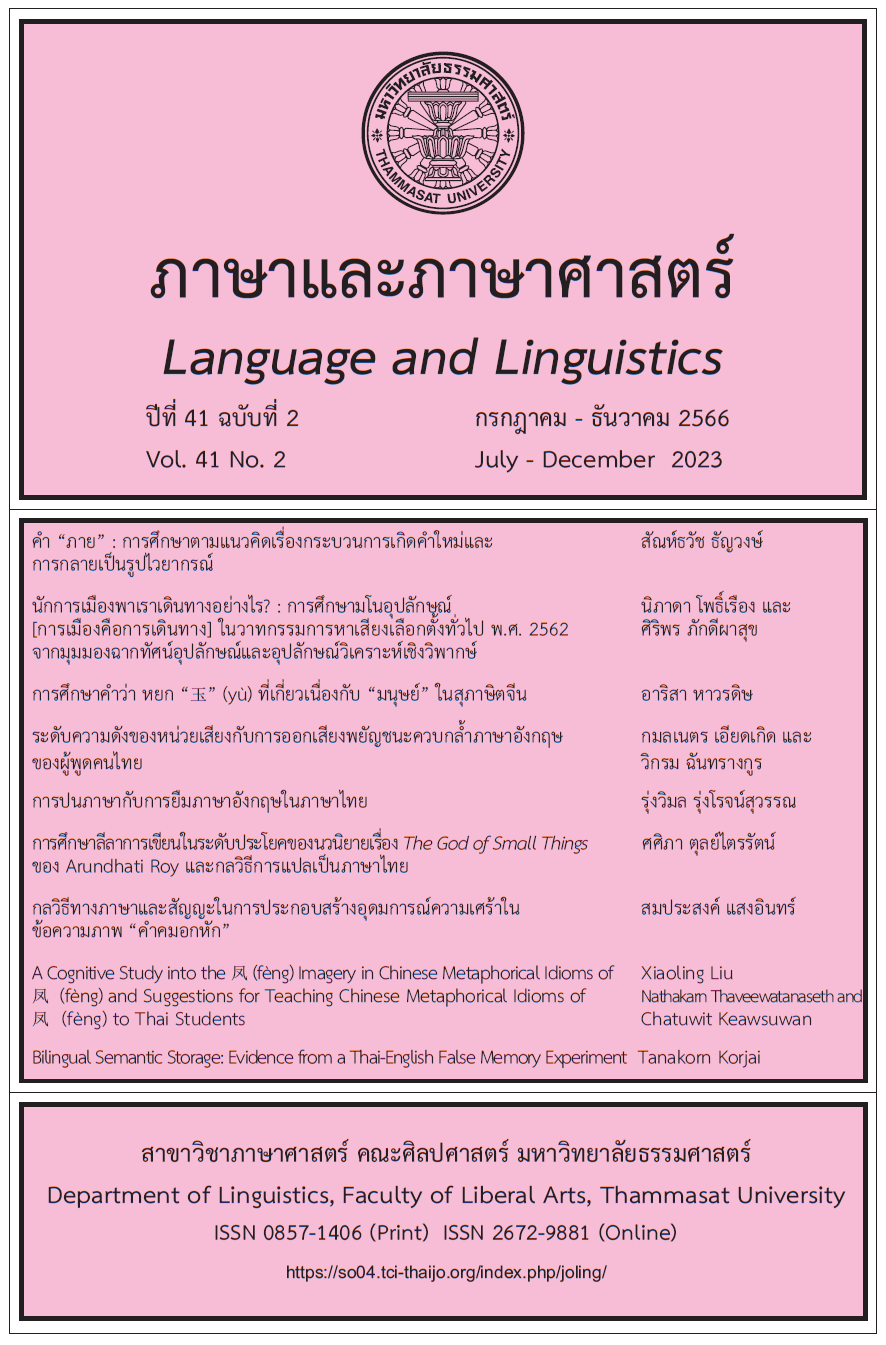Bilingual Semantic Storage: Evidence from a Thai-English False Memory Experiment
Main Article Content
Abstract
Before code-mixing sentences can be conceptualised and structured, bilinguals necessarily access their semantic knowledge in their cognition. This is where the debate over whether semantic storage of bilinguals is shared or separate plays a role. The current study applied a code-mixing context to a psycholinguistic experiment, specifically exploring whether semantic storage is shared or separate. A false memory experiment was run. The results show a possibility and a tendency to support the shared storage argument and the Revised Hierarchical Model. The analyses also suggested the possible relation between language proficiency and the use of code-mixing in conversations.
Article Details

This work is licensed under a Creative Commons Attribution-NonCommercial-NoDerivatives 4.0 International License.
บทความทุกบทความเป็นลิขสิทธิ์ของภาษาและภาษาศาสตร์
References
Akhtar, H., Khan, A., & Fareed, M. (2016). Code-mixing and code-switching in EFL/ESL context: A sociolinguistic approach. Balochistan Journal of Linguistics, 4, 29-42.
Babaii, E., & Shahri, S. (2010). Psychometric rivalry: The C-test and the cloze test interacting with test takers’ characteristics. In R. Grotjahn (Ed.), Der C-Test: Beiträge aus der aktuellen Forschung /The C-Test: Contributions from current research (pp. 41-56). Peter Lang.
Baddeley, A. D., Thomson, N., & Buchanan, M. (1975). Word length and the structure of short-term memory. Journal of Verbal Learning and Verbal Behaviour, 14, 575-589.
Bates, D., Maechler, M., Bolker, B., & Walker, S. (2015). Fitting linear mixed-effects models using lme4. Journal of Statistical Software, 67(1), 1-48. https://doi:10.18637/jss.v067.i01
Bates, D., & Maechler, M. (2021). Matrix: Sparse and dense matrix classes and methods (R package version 1.4-0) [Computer software]. CRAN. https://CRAN.R-project.org/package=Matrix
Brysbaert, M., & Duyck, W. (2010). Is it time to leave behind the revised hierarchical model of bilingual processing after fifteen years of service?. Bilingualism: Language and Cognition, 13(3), 359-371. https://doi.org/10.1017/S1366728909990344
Chaiwichian, U. (2007). Thai-English code switching of students in the mini English program (MEP) [Master’s thesis, Suranaree University of Technology]. Suranaree University of Technology Intellectual Repository.
Deese, J. (1959). On the prediction of occurrence of particular verbal intrusions in immediate recall. Journal of Experimental Psychology, 58, 17-22.
De Bot, K. (1992). A bilingual production model: Levelt’s ‘speaking’ model adapted. Applied Linguistics, 13(1), 1-24.
De Groot, A. M. B. (1993). Word-type effects in bilingual processing tasks: Support for a mixed-representational system. In R. Schreuder & B. Weltens (Eds.), The bilingual lexicon (pp. 27-51). John Benjamins. https://doi.org/10.1075/sibil.6.04gro
Dong, Y., Gui, S., Macwhiney, B. (2005). Shared and separate meanings in the bilingual mental lexicon. Bilingualism: Language and Cognition, 8(3), 221-238. https://doi.org/10.1017/S1366728905002270
Durgunoglu, A. Y., & Roediger, H. L. (1987). Test differences in accessing bilingual memory. Journal of Memory and Language, 26, 377-391.
Graves, D. F., & Altarriba, J. (2014). False memories in bilingual speakers. In R. R. Heredia & J. Altarriba (Eds.), Foundations of bilingual memory (pp. 205-221). Springer. https://doi.org/10.1007/978-1-4614-9218-4_10
Hahyaesalaemae, K. (2017). Analysis of the use of code mixing between Thai and English language in Facebook: A study in Thai Youngers account. Edulitics Journal, 2(2), 78-83.
Kangkha, P., & Mahadi, T. S. T. (2018). Code switching in Thai society: Four decades of research. International Journal of Language Literacy & Translation (IJoLLT), 1(1), 21-36
Kirsner, K., Smith, M. C., Lockhart, R. S., King, M. L., & Jain, M. (1984). The bilingual lexicon: Language-specific units in an integrated network. Journal of Verbal Learning & Verbal Behavior, 23(4), 519-539. https://doi.org/10.1016/S0022-5371(84)90336-0
Kroll, J. F., & Stewart, E. (1994). Category interference in translation and picture naming: Evidence for asymmetric connection between bilingual memory representations. Journal of Memory and Language, 33(2), 149-174.
Kroll, J. F., & Tokowicz, N. (2005). Models of bilingual representation and processing: Looking back and to the future. In J. F. Kroll & A. M. B. de Groot (Eds.), Handbook of bilingualism: Psycholinguistic approaches (pp. 531–553). Oxford University Press.
Madriñan, M. S. (2014). The use of first language in the second-language classroom: A Support for Second Language Acquisition. Gist Education and Learning Research Journal, 9, 50-66.
Marmolejo, G., Diliberto-Macaluso, K. A., & Altarriba, J. (2009). False memory in bilinguals: Does switching languages increase false memories?. American Journal of Psychology, 122(1), 1-16.
Menenti, L., & Indefrey, P. (2006). L2-L1 word association in bilinguals: Direct evidence. Nijmegen CNS, 1, 17-24.
Mitchel, A. (2005). Do bilinguals access a shared or separate conceptual store? Creating false memories in a mixed-language paradiam. Psychology Honors Projects. https://digitalcommons.macalester.edu/psychology_honors/1
Potter, M. C., So, K.-f., von Eckardt, B., & Feldman, L. B. (1984). Lexical and conceptual representation in beginning and proficient bilinguals. Journal of Verbal Learning & Verbal Behavior, 23(1), 23-38. https://doi.org/10.1016/S0022-5371(84)90489-4
Promnath, K., & Tayjasanant, C. (2016). English-Thai code-switching of teachers in ESP classes. PASAA: Journal of Language Teaching and Learning in Thailand, 51, 97-126.
R Core Team (2021). R: A language and environment for statistical computing. R Foundation for Statistical Computing. https://www.R-project.org/
Riesthuis, P., Otgaar, H., & Wang, J. (2019). Difference between bilinguals and monolinguals in false memory production?: A look into the DRM paradigm using contextual details. Psychological Research on Urban Society, 2(2), 88-97. https://doi.org/10.7454/proust.v2i2.50
Roediger, H., & McDermott, K. B. (1995). Creating false memories: Remembering words not presented in lists. Journal of Experiment Psychology: Learning, Memory, and Cognition, 21(4), 803-814.
Sahlin, B. H., Harding, M. G., & Seamon, J. G. (2005). When do false memories cross language boundaries in English-Spanish bilinguals?. Memory & Cognition, 33(8), 1414-1421.
Sridhar, S. N., & Sridhar, K. (1980). The syntax and psycholinguistics of bilingual code mixing. Canadian Journal of Psychology/ Revue Canadienne de Psychologie, 34(4), 407-416.
Venables, W. N. & Ripley, B. D. (2002) Modern Applied Statistics with S. (4th ed.). Springer.
Weinreich, U. (1953). Languages in contact: Findings and problems. Mouton.
Yang, L. (2020). A cross-linguistic form and meaning priming study on Mandarin Chinese multilingual speakers [Master’s thesis, University of Bergen]. Bergen Open Research Archive.
Yiamkhamnuan, J. (2011). The mixing of Thai and English: Communicative Strategies in Internet chat rooms. Kasetsart Journal, 32(3), 478-492.


